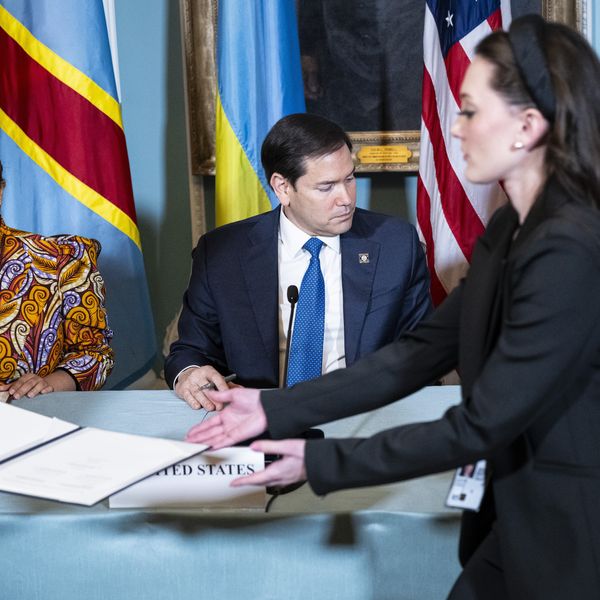President Biden released a budget proposal this week that’s full of historically high spending in just about every part of the sprawling federal government.
This includes the Department of Defense, which would work with a $773 billion budget in the upcoming fiscal year (FY 2023) if the president has his way. And while a wide variety of stakeholders from Democratic lawmakers to progressive organizations to taxpayer advocacy groups have criticized the high level of military spending in Biden’s new budget proposal, the defense hawks on Capitol Hill are already jumping up and down to claim the president’s defense budget is not nearly high enough.
The top Republicans on the Senate and House Armed Services Committees — Sen. Jim Inhofe (R-Okla.) and Rep. Mike Rogers (R-Ala.), respectively — ominously warned last week that anything less than military spending of five percent above inflation would make the United States unable “to defend our nation or our allies in the future.”
After President Biden released his budget this week — proposing a roughly 6.2 percent boost to DoD in 2023 over 2022 levels, and 9.8 percent above 2021 levels, on a non-inflationary basis — Inhofe and Rogers called the request “inadequate” and suggested it was weak against China’s military buildup. Senate Budget Committee Ranking Member Lindsey Graham (R-S.C.) decried the Biden defense request as “woefully inadequate and dangerous,” while ironically warning that the government spending more money under the Biden budget would make inflation in America worse.
All of these lawmakers — and important defense hawks outside government, most notably The Wall Street Journal editorial board — are singing from the same chorus this week, claiming defense spending needs to increase several percentage points above inflation.
Set aside the fallacy of this argument — for just a moment — and consider how difficult it is for budget and military planners to determine what this ‘inflation plus’ target should even be. Ranking Members Inhofe and Rogers are correct to critique some of the Biden administration’s economic assumptions — which certainly underestimated inflation for 2021 and likely underestimate inflation for 2022 — but Inhofe and Rogers themselves predict that inflation could be anywhere from five to eight percent in 2022. With appropriators working off of a $736 billion DoD budget that just passed for the current fiscal year, those three points between five and eight percent can make a $20 billion-plus difference.
Would Inhofe and Rogers prefer a military budget increase that assumes five percent inflation — or a 10 percent total increase, given their demands for increasing the budget five percent above inflation — or an increase that assumes eight percent inflation, a 13 percent total increase? We know the answer based on all their prior defense budget work.
And a 13 percent increase to the DoD budget would be massive. The DoD budget would climb nearly $100 billion, from $736 billion in FY 2022 to $832 billion in FY 2023. That $832 billion DoD topline would be a staggering 18 percent higher than the FY 2021 budget of $704 billion, the last DoD budget to pass under hawkish former President Donald Trump.
The Journal’s editorial board might even criticize that $832 billion DoD budget, though, as not nearly high enough. In a lengthy editorial published this week lamenting an alleged “declining military” under President Biden, the board closes an 800-word complaint about the impoverished, $700-billion-per-year Defense Department with a presumed call to arms for hawkish lawmakers on the Hill: “Congress should set a goal of returning the U.S. to its deterrent strength of the Cold War years, when defense spending was 5% or more of the economy.”
Sounds innocent enough — just a small slice of America’s economic output — until one runs the numbers.
Under one measure of the Biden administration’s assumptions for the size of the economy over the next 10 years — gross domestic product in current dollars — the DoD budget under the Journal editorial board’s plan would be over $1.2 trillion in FY 2023. That’s a nearly $500 billion, or 67 percent, increase over FY 2022 amounts. The nominal DoD budget total would rise to nearly $1.9 trillion in FY 2032.
Nowhere in these missives from defense hawks or screeds from editorial boards is a serious engagement with an important, underlying question: does growth (or reduction) in the size of the defense budget need to be tied to inflation, or to the size of the economy, at all?
Regarding the latter, there’s no credible case that the United States should indefinitely tie the size of its military budget to the size of its economy. While economic growth no doubt creates new or additional security challenges — think, for example, of the cybersecurity challenges that have arisen with the ubiquity of the internet, which has also grown the economies of America and much of the developed world — economic growth alone does not alter the size or composition of domestic and global security challenges facing America and its allies.
The Journal’s editorial board does not make any compelling case for why the defense budget needs to match five percent of the size of the economy from year to year, levels not seen since the United States and the Soviet Union regularly came to the brink of nuclear war and engaged in decades-long arms races and proxy wars.
Defense hawks arguing for the military budget to outpace inflation similarly do not make a compelling case for their ‘inflation-plus’ plus-ups. Their regular fallback for this argument is a now four-year old commission recommendation that was barely justified in a 116-page paper and described as “more illustrative than definitive.” It’s worth noting, too, that many of these defense hawks won’t make similar arguments about any other part of the federal budget — nor should they.
Now, for some parts of the defense budget, inflation adjustments may make sense. Servicemember and civilian pay sticks out as one need. Fuel and food budgets are other components that may need to go up to account for historic levels of inflation. Meeting these needs under a topline budget that’s flat (or reduced) on an inflation-adjusted basis could actually force DoD to be more efficient, cutting out wasteful procurements and scrapping legacy programs that are too troubled or too expensive to maintain.
But calling for another $100 billion, primarily for DoD to buy more planes that can’t fly and keep ships that are too expensive afloat? That’s a fool’s errand, pursued by lawmakers and stakeholders for whom no DoD topline will ever be high enough. And, as Quincy Institute’s William Hartung wrote just a few days ago, the Biden DoD budget request is too damn high as it is.














